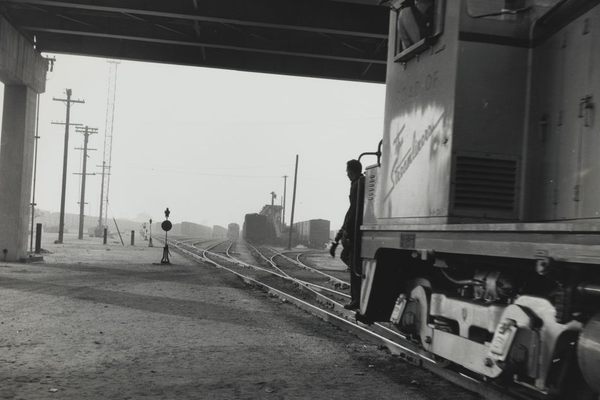When Pigs and Other Farm Animals Fly

Dairy cows eye their potential future. (Photo: Kristina D.C. Hoeppner/Flickr)
Next time you trace a nice contrail across the sky, or end up next to another plane on the runway, think twice before you wave. It’s increasingly likely that the passengers are not people, but cows, sheep, or goats.
People have been flying large animals overseas since before World War II, when America sent mules to Southeast Asia as part of an economic development program. But rapidly growing meat and dairy markets, often situated far from established trade routes, have meant more and more planes are now stuffed nose to tail with livestock.
Though you might not think of them as international travelers, “there are animals moving all the time,” says Bill Patten, a transport expert with Australia’s Livestock Air Corporation (motto: “We Give Horses Wings”). Many of the jetset animals are coming from Australia, the world’s largest exporter of livestock. Last year, the country sent about 1.2 million cattle to southeast Asia, and 2.3 million sheep to the Middle East.
As we spoke, Patten was accompanying a group of 25 camels, horses and ponies to a theme park in the Philippines. Though boat transport remains the most popular option, this group, like hundreds of thousands of their fellows, traveled by air.
Most animal planes take off from ordinary commercial airports–“we just rock up at much the same area where [passengers] get off,” says Patten. Freight workers load crates into the plane, generally in a prefigured arrangement to increase air flow, and the barn takes off. Livestock supervisors sit upstairs in business class, or with the pilot. There are no in-flight movies, no safety videos, and usually no problems, though sometimes the animals get bothered by turbulence. Crates and excrement mats are destroyed upon landing.
Planes with animal passengers are subject to strict weight and density regulations. Still, just as with humans, there’s a distinct correlation between crowding and status. You can fit thousands of sheep in a 747 (engineers have developed ways to modify air circulation so that you can put them in all the compartments), but it’s rare you’ll find more than a couple hundred breeding pigs on the same flight, says Jay Truitt of the U.S. Livestock Exporters Association, since each needs her own crate, feed trough, and water.
Top racehorses are in a class of their own: ”Obviously those don’t fly in the same plane as you’d fly a group of dairy heifers,” says Truitt, “namely because the buyer often has his own G6 or 747 and he takes care of it.”
What happens after their journey depends on the species involved. Most sheep are shipped live specifically so that they can be slaughtered locally, either during religious rites or at the ”wet market,” where shoppers buy fresh meat. “They don’t like it frozen,” explains Patten, and in any case, “in a lot of places they don’t have the facilities to freeze it.” It’s easier to let sheep keep themselves alive for the duration of the trip than to risk shipping meat that could thaw out and rot.

The Boeing 747-400 is a popular livestock transport model. (Photo: Adrian Pingstone/WikiCommons Public Domain)
Live cows, meanwhile, are in demand for reasons other than freshness. Farmers might import lives heifers to ”make a big jump genetically,” says Truitt. United States dairy cows make three to four times more milk than those in other markets, and so some overseas farmers bring them in to increase overall productivity. Others buy exclusively American: ”When they build a new facility, a lot of folks would just as soon start with high-end genetics in the first place,” Truitt says. Hundreds of thousands of cows leave the U.S. every year to start families elsewhere.
Those who have more expected of them upon landing are more likely to get the airplane treatment, explains Truitt. “Animals are just like human beings when it comes to reacting to stress,” he says, “and if you’re spending several thousand dollars for a dairy heifer, you obviously want her to be in as good a shape as you possibly can.” Putting her on a boat might mean days at sea followed by a very bumpy truck ride inland. So even though it’s more expensive and holds fewer animals, ”a plane is faster, and a plane can land closer,” says Truitt, leaving less time for animals to get freaked out or for something to go wrong.
Still, problems can arise. A Singapore Airlines flight made news in late October when the pilot had to land after sheep emissions–code for flatulence and manure–set off the smoke alarm (this happens with cows, too). And animal rights groups object not just to the conditions of transport, but to the fate that economy-class animals meet at their destinations. Because of these concerns, New Zealand, previously the world’s leading sheep exporter, hasn’t transported livestock for slaughter since 2005.
But those who travel alongside the cargo have a different view. “A lot of them are pretty spoiled animals,” says Truitt. Also, the past was much worse: ”You see pictures of them going on boats and being lifted up by cranes to get onto ships,” Patten explains. “It’s pretty odd. I can’t imagine how it all happened that way.”
Naturecultures is a weekly column that explores the changing relationships between humanity and wilder things. Have something you want covered (or uncovered)? Send tips to cara@atlasobscura.com.











Follow us on Twitter to get the latest on the world's hidden wonders.
Like us on Facebook to get the latest on the world's hidden wonders.
Follow us on Twitter Like us on Facebook